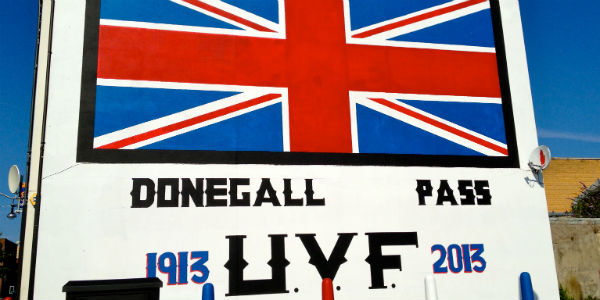Brexit has blown open the unreconciled divisions in Northern Ireland
The British and Irish governments have long tried to keep a lid on the tensions in Northern Ireland. But Brexit, argues Duncan Morrow (Ulster University) has exposed the weaknesses of the Good Friday and St Andrew’s Agreements – deals that never required each side to give up their aims of ruling Northern Ireland alone. Now these unreconciled political narratives are exposed again to the outside world. The question of whether Brexit shapes the future of Northern Ireland, or Northern Ireland shapes Brexit, is still completely unresolved.

Mural in Belfast, 2013. Photo: Allan Leonard via a CC-BY-NC 2.0 licence
‘Northern Ireland’ came into being more as a tactic than a goal. Originally, it was a British innovation to manage a breakdown in legitimacy in Ireland that threatened to escalate beyond control. Ulster Unionists adopted the cause of ‘Northern Ireland’ only belatedly – when it became their best available option to maintain their own political voice. But even they saw it as an instrument to a protect their British identity against Irish nationalism rather than an end in itself.
Although no Irish nationalists wanted Northern Ireland, a majority in the South eventually acquiesced in its pragmatic value, to the point of defending the settlement in their own civil war. Northern Nationalists – required not only to accept partition but to live on the Unionist side of it – never accepted it, and were in a position to resist in many parts of the new experiment. But while Northern Ireland miraculously removed British-Irish tensions from the rest of Britain and Ireland, it embedded sectarian antagonism within.
Northern Ireland’s intractability was the obvious reason why everyone outside it made every effort to stop themselves from becoming entangled in it. Paradoxically, its suspicions and antagonism were also its most obvious badge of distinctiveness. Chronic hostility was Northern Ireland’s identity, creating its own ‘normal’, its own rituals, structures, habits and political narratives. Northern Ireland was the ’container’ in every sense: it contained (constrained) violence between Britain and Ireland, but also contained its own internal violence. Northern Ireland still has both a persistent identity-deficit and is more clearly distinctive than everywhere around it. But the biggest difference was now no longer between Britain and Ireland, but between inside and outside the antagonism.
Containment depended on two conditions: the antagonism must not escalate into open violence, thus rendering it deniable – and, on that basis, outside powers could sidestep Northern Ireland while attending to their own dealings. When Northern Ireland’s tensions escalated rapidly into a vortex of murderous violence between 1968 and 1972, Britain and Ireland found themselves unwillingly drawn back to their unresolved historic dilemma.
It took until 1985 for the British and Irish government to recast the Northern Irish crisis as a problem requiring inter-governmental leadership. ‘Reconciliation’ in Northern Ireland became the basis for a historically new partnership between London and Dublin, with active support from Europe and America. Problematically, the principle of rapprochement had few takers in Northern Ireland. Nonetheless, after 13 years of effort, and despite many ups and downs, the majority of Northern Ireland’s politicians signed up in principle in Belfast on Good Friday 1998.
The Agreement was endorsed by 72% of Northern Irish voters – compared to Brexit, an overwhelming mandate. But while it affirmed the broad consensus that consent, power-sharing and non-violence were essential to institutional stability in the present, they were only made possible by limiting efforts to resolve the conundrums of either the past or the future. The legacy of violence was declared ‘tragic and regrettable’, yet the Agreement was studiously neutral on the question of responsibility or blame. Although all sides committed “to strive in every practical way towards reconciliation and rapprochement”, each did so without being required to change anything about their aspirations to rule Northern Ireland alone. So while the document was accommodating in its design, the signatories – especially those in Northern Ireland – could sign it while remaining single-mindedly committed to diametrically opposed views of both past and future. For its strongest champions in Dublin, London, Washington and Brussels, reconciliation was a strategic ‘new beginning’. For many of its signatories in Belfast, reconciliation was a compromise tactic, not to be mistaken for an ultimate goal.
The history of Northern Ireland since 1998 was inevitably also the history of the rise and fall of reconciliation. For the first nine years after signing, hopes of implementing stable, shared political institutions were slowly dashed as Unionists and Republicans faced off over the question of who should first demonstrate their good faith. Unionist demands that Republicans disarm before participating in government were met with Republican insistence that disarmament would only follow evidence of change in the nature of government.
As polarisation set in again, the British and Irish governments subtly re-calibrated the Agreement at St Andrews in 2006. ‘Peace’ was stripped back to its pragmatic essential of viable institutions, rather than new relationships. To this end, the government watered down the requirement for mutual endorsement by the parties in government and downplayed the importance of equality law, integrated education, shared housing, civic forums, bills of rights or a shared future. All that was required now was evidence of disarmament by the IRA, commitment to the policing arrangements by Sinn Fein and commitment to operate North-South institutions and to devolve powers for policing and justice at a future date by the Democratic Unionists.
In 2007, the prize of partnership government was finally achieved. Previously unthinkable pictures of past enemies smiling in harmony seemed to seal a new deal. With shared government established and the rule of law in place, Northern Ireland was removed from the front line of international and intergovernmental interest and declared resolved.
On the surface, reconciliation had triumphed over division. But by stepping away, the governments chose to ignore the evidence that power had been returned to parties for whom reconciliation was a method, or a tactic, never the goal. Now that government was re-established in Belfast, both Ireland and the UK could at last become less interested in the quality of partnership than in its existence.
To the outside world, the symbol of shared government and the continuity of government spelled progress. But internally, the Executive was subject to repeated breakdowns over unresolved issues of responsibility for killing and contentious cultural symbols, and made no progress on delivering an integrated rather than segregated future. The permanent crisis was replaced by repeated mini-crises over policing, flags, parades, the past, paramilitaries and language. Constitutional instruments designed to ensure inter-community fairness became vehicles for single-party veto. Almost every year since 2010, the situation required outside intervention. In each case, the consistent priority of both London and Dublin was to restore institutions rather than take additional responsibility to address unresolved issues at depth. For as long as devolution could be restored, the welcome and radical reduction in violence in Northern Ireland meant that any challenges to reconciliation were technical rather than systemic.
This time, the continuing weakness of the 1998 framework in the face of national antagonism has been starkly revealed. Although the immediate focus of local political attention was a breakdown over Assembly accountability brought on by revelations of serious financial problems with a Renewable Heating Initiative (RHI), the fragility of inter-community partnership was exposed when relations took on sectarian overtones after Sinn Fein withdrew from the Executive. Sinn Fein’s advances among nationalist voters in February were followed by a swing to the DUP among Unionists in the Westminster elections in June, elections that catapulted the DUP into a pivotal position in London.
But it is increasingly clear that the additional, and dramatic, new element is not local, but the enormous stress being put on the British-Irish framework underpinning the Good Friday system as a result of Brexit. For the first time since 1985, the governments of the UK and Ireland have adopted radically different approaches to the fundamental underpinnings of the Agreement: sovereignty, borders and citizenship. Alongside the disappearance of European and American sponsorship of a shared peace, Brexit appears to be dissolving the local and the international structure of reconciliation in Northern Ireland, creating a renewed crisis of primary national interests and no obvious consensus space for a deeply divided society like Northern Ireland.
Who now makes reconciliation a priority, and what happens to the Good Friday Agreement if it is not? Superficially nothing has yet changed, but the immediate future of partnership in and over Northern Ireland may now depend on whether sustaining this model of reconciliation defines the shape of Brexit, or whether a specific model of Brexit is applied uniformly to define relations for the whole UK including Northern Ireland. Crucially, these are decisions being made in London.
All of a sudden, both the question of whether reconciliation in Northern Ireland is a temporary tactic or a strategic goal – and whether British commitment to sovereignty over Northern Ireland is itself ultimately a tactical ‘management’ question – have returned as matters of the utmost strategic, selfish interest. The question of what is the tactic and what is the goal have not been so urgent for a century.
This post represents the views of the author and not those of Democratic Audit.
 Professor Duncan Morrow is a lecturer in politics at Ulster University and has published widely in the fields of conflict resolution, Northern Ireland politics and the relationship between religion and politics.
Professor Duncan Morrow is a lecturer in politics at Ulster University and has published widely in the fields of conflict resolution, Northern Ireland politics and the relationship between religion and politics.





 Democratic Audit's core funding is provided by the Joseph Rowntree Charitable Trust. Additional funding is provided by the London School of Economics.
Democratic Audit's core funding is provided by the Joseph Rowntree Charitable Trust. Additional funding is provided by the London School of Economics.
[…] This post represents the views of the author and not those of the Brexit blog, nor the LSE. It first appeared at Democratic Audit. […]
Thankfully we have people studying and reflecting on the fragile nature of our politics and relationships.